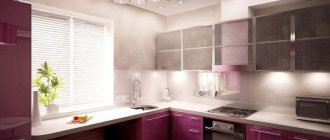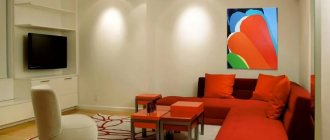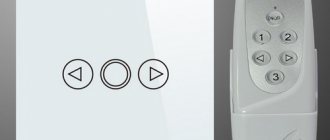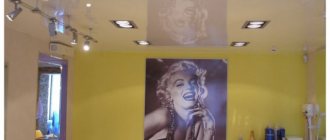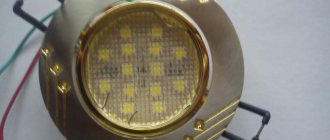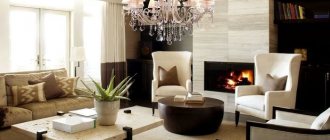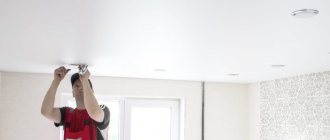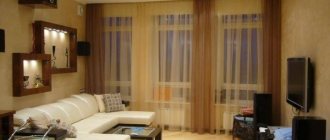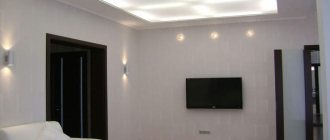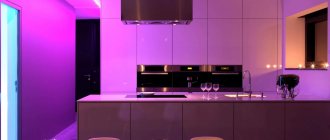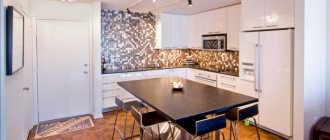There are still doubters about whether spotlights are needed in the interior. There are thoughts that this is just a waste of money, and you can completely do without them. Why come up with something extra when it’s easier to hang a chandelier on the ceiling, add sconces, and that will be enough to illuminate the room. Maybe in some sense it is true. But let’s consider all the possibilities of spotlights, and the last doubts of skeptics will disappear, because the possibilities of such lighting are enormous.
Types and types of point light sources
The modern consumer does not have to be limited when choosing these light sources. Each brand specializing in lighting products has many different models. All of them are divided into two types according to the installation method. There are overhead and recessed ceiling spotlights.
The use of overhead devices is advisable if it is necessary to create a modern lighting system without affecting the dimensions of the room. These models can be fixed on concrete and brick surfaces. There is no need to equip hanging, tension systems. For surface-mounted spotlights for ceilings, the size of the body with the diffuser is larger than the dimensions of the mounting platform. She disguises herself and remains invisible.
Ceiling spotlights can be fixed on any surface
With the growing popularity of stretch and suspended ceilings, built-in light sources have become in particular demand. These models have a wide range of applications. They can be mounted:
- in tension systems;
- on plasterboard and panel ceilings;
- in a furniture partition;
- in the niches of the walls.
In addition, these devices are used in the design of stairs, floors, bar counters, swimming pools, etc.
Spotlights are used in the design of stairs
What types of spots are there?
Products are classified by type of fastening. There are the following types of spots.
Ceiling spots
They become a complement to central lighting or completely replace it. The advantage of ceiling products is that it provides the ability to change the direction of the reflector. Thanks to this, you can focus on different interior details, highlight a work area or a place to relax. These lamps have small dimensions, so they are suitable for rooms with low ceilings.
The photo shows the design of a small kitchen with a ceiling equipped with black spotlights.
Wall spots
Such models can be excellent decorative lighting for hanging shelves or wall paintings. Placing the spots above a desk or computer desk will not take up much space and will completely replace a table lamp. Wall-mounted products are also sometimes used as a night light, the main thing is to choose the right power.
The photo shows wall spots located above the TV area in the living room interior.
Built-in
Built-in structures are known to many as adjustable spotlights. In this case, the direction of the light can be slightly changed. Built-in spot spots are used to illuminate small functional areas. To achieve uniform illumination, you can slightly adjust the light flow.
The dimensions of the spot devices are small, and installation requires only making a small hole in the suspended ceiling. Ceiling recessed luminaires are installed using spring clamps.
Invoices
Overhead rotary structures differ from built-in lamps only in the installation method. According to the installation method, they most closely resemble sconces. A special bracket is used to secure them. It is attached to the ceiling, and a lamp is attached to it using screws.
Their advantage is that there is no need to cut a hole in the ceiling. This will allow you to change designs to others at any time.
Complexly combined
The devices differ from spot ones only in that one housing can contain several light sources that can be directed independently. Such designs are most similar to chandeliers. Their main advantage is the ability to effectively illuminate all rooms and direct streams of light even to remote corners of the room.
In addition to the above types, spots are divided according to the shape of the base. There are spots on a bar, as well as designs on a square, round or flat base.
Spots with bracket mounting
It is a very popular type of mount, which allows for free change of light direction. Products may have one or more reflectors. The open mount has different shapes, thereby creating a complete structure that looks quite impressive.
Spots with pole mounting
This model is equipped with several lamps arranged in one straight or curved line. Certain products have a flexible rod that can take on any configuration. With the help of such fastening, the devices are used as original lighting for niches or walls. The design can also act as central lighting for a small room.
The photo shows ceiling spots on a square-shaped rod in the interior.
Design Features
The high consumer demand enjoyed by surface-mounted and recessed ceiling spotlights forces manufacturers to constantly expand their range and modify models. Now there are different types of structures on the market. One of the important indicators of devices is adjustment. It determines the comfort of use and the purpose of the device.
In addition to standard devices that provide light flow in a certain direction with a specific intensity, the range includes point light sources:
- with a rotary and retractable mechanism;
- gimbals;
- downlights;
- spots.
The presence of a rotary and retractable mechanism allows you to adjust the direction of the light flux and provide comfortable lighting in the desired area. Gimbal designs include multiple light sources. They are equipped with adjustments to select the desired lighting intensity and direction of flow.
Swivel and retractable spotlight
Downlights are used to create accents in the interior. They create effective illumination of certain objects and areas.
Downlights create effective illumination
Spots are very popular now. These devices have manual adjustment of the direction of the light flow. In this category, you can choose a recessed and surface-mounted spotlight for the ceiling. The product range is large, including models of different shapes, sizes, and design styles.
Spots allow you to change the direction of the light flow
Room lighting ideas
Each room should have its own scenario depending on how it is used.
Bedroom
In this room you need to highlight the following locations - a bed, a mirror and a dressing table, a wardrobe, an armchair. The sector above the sleeping area can be decorated in the “starry sky” style using fiber optics. The two-level ceiling with a protrusion in the shape of a bed, turned into a large lamp, attracts the eye. For lighting in a bedroom without a chandelier, floor panels are increasingly being installed into the podium.
Living room
In a hall or office, you can arrange hidden lighting by installing LED lighting in other interior elements - for example, furniture. Also, you can’t do without one or even a pair of floor lamps next to the chairs. Be sure to highlight the dining table if the room is also used for receiving guests.
Kitchen
Here you need to provide illumination for two zones - working and dining. The distance from the lampshade to the tabletop should be about 50-70 cm, or 1.30-1.4 from the floor. This can be achieved using wall sconces with offset. It is convenient to use track systems with rotating lampshades to illuminate the work surface well.
Hallway
Spotlights and LED panels are ideal for a tiny corridor. A luminous ceiling always looks advantageous here, which will also help “correct” the problematic geometry of the room.
Lighting with secondary, in the understanding of the average person, lamps with proper planning and calculations is better, brighter and more uniform. However, we should not forget that a chandelier is a bright object, the highlight of the interior. Therefore, you first need to consider all lighting design options, and only then make a decision about which project is more acceptable from an aesthetic and practical point of view.
Lamp arrangement
All spotlights have a similar design, including:
- mounting base;
- housing with diffuser;
- Light source;
- connecting cable.
Arrangement of spotlights
The model range of these lighting products includes various modifications with more complex designs and additional devices. Built-in and overhead ceiling spotlights can be adjusted by remote devices. There are models with an extended lighting angle, equipped with dimming that corrects the illumination. Lamps differ in the level of protection from dust and moisture, which determines the scope of their intended use.
Various modifications of ceiling spotlights
Ceiling shapes
The most common ceiling forms.
Round
Allows you to diversify the interior and make its design truly special. It can be illuminated using any original shade that matches the style of the room.
With a niche
Such models with a box provide clear boundaries of lighting and are a fairly popular interior solution.
Rectangular and square
Hidden lighting will make rectangular or square shapes more noticeable and will not allow them to blend into the general background.
Figured
The wave ceiling looks quite charming; in combination with various lighting effects, it opens up wide possibilities for various experiments.
Light sources in spotlights
Various types of lamps can be installed in these lighting devices. Manufacturers' products include incandescent, halogen and fluorescent light sources. All of these devices have certain pros and cons. But the best option is LED ceiling spotlights. They have several obvious advantages that set them apart from other light sources.
LEDs:
- have maximum light output;
- use electrical energy economically;
- create uniform light;
- have the longest service life.
LED ceiling spotlights
These devices have another important advantage. The LED recessed ceiling lamp can be installed in tension systems without fear for the integrity of the canvas. During operation, these light sources practically do not emit heat and do not have a negative impact on the structure of the polyvinyl chloride coating.
Ceiling recessed luminaire can be installed in tension systems
Manufacturers of spotlights
Russian manufacturers – Ambrella Light, Donolux, Elektroatandart. The products meet a high level of quality and are designed for a wide price range.
Foreign companies specializing in the production of lighting systems include: ARTE LAMP (Italy), EGLO (Austria), Lightstar, LUSSOLE (Italy), Massive (Belgium), Novotech (Hungary).
Advice! When choosing a manufacturer, do not chase low cost. Good quality doesn't come cheap.
Compact and miniature assistants help not only to transform the interior. Their benefits cannot be overestimated, because the state of our vision, mood, and therefore health in general directly depends on proper lighting.
Pros and cons of using spotlights
The main advantages of using these devices in the interior can be seen in numerous photos of spot lighting for ceilings. Using such light sources you can:
- create a system of main or additional lighting;
- perform zoning, provide lighting for a certain part of the room;
- give the interior the desired mood and character.
The compactness of the devices and installation features allow the lamps to remain virtually unnoticed. They have no effect on the interior. Therefore, you can use them in any design. The assortment also includes models with expressive decor that can decorate the interior, support, and emphasize style.
Ceiling spotlights will fit into any interior style
In the photo of ceiling spotlights you can see how well these devices zoning a room. This lighting system allows for efficient use of electricity and provides light only where it is needed. The advantage of these devices is the specific distribution of flows, eliminating the formation of shadows. This is important if you need to equip a workplace to perform small operations.
Spotlights provide room zoning
The use of recessed ceiling spotlights guarantees a reduction in electricity costs. LED and halogen lamps consume minimal amounts of energy. Additional savings are ensured by the use of lighting only in the required areas and the long service life of the light bulbs.
The advantage of these devices is the unlimited choice of installation location. Overhead and recessed ceiling spotlights can be placed in any area, decorating arches, niches, etc. This versatility makes it possible to create a unique, interesting design in a room.
Spotlights create a unique design in a room
LEDs can have a white or yellow, colored glow. This factor expands the possibilities for implementing creative projects. With the help of warm, cold tones, shades of light, you can give the interior different characters, create a comfortable atmosphere, taking into account personal preferences.
The disadvantages of built-in and surface-mounted spotlights for ceilings include a certain complexity of installation and the need to develop a professional installation diagram. In addition, when using models with 12V lamps, you need to additionally purchase a step-down transformer. But these shortcomings are not a big deal.
Backlight colors
A certain color or shade shapes the mood of the entire interior.
Neon
Flexible neon has a soft blue or blue glow. This cool shade looks great in both larger and smaller rooms.
Pink
Creates a magical atmosphere and incredibly beautifully envelops individual fragments of the room with magical light.
The photo shows a bedroom and a single-level gray ceiling with pink lighting.
Color (RGB)
Provides several multi-colored options that allow you to customize the ceiling model to suit any mood.
Yellow
It is a rather positive and bright interior solution.
Purple
A non-trivial option that is suitable for those who love non-standard and extravagant design.
White
The simplest, but at the same time very stylish and effective type of lighting, creating a uniform white light flux.
Basic rules for selecting point models
A large assortment of built-in and surface-mounted spotlights can create certain difficulties when choosing. If it is necessary to install these devices in suspended, tension systems, it is necessary to decide on the type and quantity in advance. Wiring for these light sources will be mounted under the ceiling covering; appropriate holes must be made in the ceiling coverings.
When choosing recessed and overhead spotlights for the ceiling, you must focus on the following criteria:
- purpose of the point light system;
- required power;
- interior style.
Spotlights serve as main lighting
These light sources can serve as main lighting. In this case, you should accurately determine the power and select the location of the lamps that provides high-quality lighting for the entire room. Often these lighting devices are additional and are mounted along with the ceiling chandelier. With such operation, less power of devices is required, and there will be no need to install many light sources. Using spot devices, only a certain area can be illuminated.
Installation of spotlights together with a ceiling chandelier
In the photo of spotlights on the ceiling, you can choose the appropriate product design. In the modern range of models, it is easy to find successful options for any style. Cases and diffusers differ in design and decor. You can choose discreet, laconic lamps, original products with complex designs.
Ceiling color
The lighting goes well with the ceiling plane of any color.
- Black.
- White.
- Beige.
- Red.
The photo shows a living room with a beige single-level ceiling with lighting.
Determining optimal power
Determining the required power depends on several factors:
- purpose of the system;
- room area;
- ceiling height;
- lamp parameters.
The use of recessed or overhead spotlights for ceilings as the main lighting requires calculations according to general rules. On average, a 35W light source is installed per 2m2 of area. If this is additional lighting, the indicators of the ceiling chandelier are subtracted from the total power. When creating comfort in a certain area, the fundamental calculation criterion is its area.
The number of spotlights depends on the size of the room
The number of light sources required depends on the type and power of the lamps. Halogen, traditional, LED recessed spotlights have different parameters. Many models are designed to accommodate any type of lamp.
Types of lamps
The choice of lamps for spotlights is also worth paying attention to, since they differ in characteristics, operating features and directly affect the quality of lighting. The number of lamps used for spots includes the following types:
- Incandescent lamps. They get very hot and can damage surrounding materials, so in built-in spots only models with a mirror reflector and a power not exceeding 60 W are used. These products are cheaper than others, but consume more electricity, and they have to be replaced more often (at best, after 1000 hours of operation).
The quality of lighting depends on the characteristics of the model Source miniledpanel.hu
- Halogen. They heat up quite strongly, which limits their scope of application; In addition, they are sensitive to voltage changes. In order for halogen lamps to work the declared service life (more than 2000 hours), you will need a protection unit - a soft starter.
Halogen lamp Source www.market-sveta.ru
- Luminescent (CFL). The main advantage is economical energy consumption. The lamp provides even, white illumination, but contains mercury and therefore requires extremely careful handling.
On a shelf in the bathroom Source ch.paulmann.com
- LED. The most practical products: do not heat up, consume energy sparingly, shine brightly, and are safe to use. The service life of different models extends to several tens of thousands of hours, so replacing numerous lamps on a suspended ceiling (a labor-intensive process) will be a rare task. Reliability and other advantages compensate for the high cost of the products.
LED rotary Source obi.ru
See also: Catalog of companies that offer the service of selection and installation of any electrical appliances or electrical equipment in general
Lamp placement options
There are no strict restrictions or recommendations regarding the placement of these devices. However, you need to carefully develop the installation diagram. The comfort of the interior and its attractiveness depend on this. Numerous photos of spotlights on the ceiling will help you find the best option.
You can develop an original placement system and create lighting decorations using such devices. But if you need to create functional lighting, it is worth considering the options that are shown in photos of spotlights. The most popular schemes are:
- rectangular;
- parallel;
- cruciform;
- arcuate;
- chess;
- square.
Placing recessed ceiling spotlights around the perimeter of the room is the best option for creating additional lighting. Light sources can be turned on simultaneously with the chandelier to create maximum intensity. This option is used when receiving guests, organizing a banquet, or a holiday. Turning on only spotlights allows you to create a cozy, intimate atmosphere.
Placement of ceiling lights around the perimeter of the room
The parallel layout is suitable for main lighting provided by point light sources. The arrangement of lamps in several rows allows for high-quality lighting of the premises and creates proper comfort. Photos of spot lighting for ceilings in this version can often be seen in galleries of modern interiors.
In a small room with a low ceiling, it is not practical to use pendant chandeliers that take up space. An excellent option for such a room would be a cross-shaped design with LED spotlights. Single models are placed in the corners, and a gimbal structure is located in the center.
A parallel lighting scheme allows for high-quality lighting of the room
Arc-shaped placement of light sources is usually used to create lighting in a specific area. This technique allows you to visually soften excessive straightforwardness and severity. This installation scheme for LED spotlights is used to design transitions between levels in tension structures.
In some cases, a rational way is to arrange the light sources in a checkerboard pattern. Such options can be seen in the photo of spot lighting of ceilings in a kitchen with an island interior, where it is necessary to provide high-quality lighting to all areas, in the dining room, and hall.
A rational way to place light sources in a checkerboard pattern
Placing appliances in a square shape is used for small rooms. This is the optimal scheme for a hallway or bathroom.
Ceiling design
The most interesting ceiling designs.
Window to the sky
A false window is an ideal solution for many interiors. The presence of lighting will enhance the effect of bottomlessness and depth of this design.
Night sky
The starry sky fascinates with its twinkling lights and its magical appeal, reminiscent of the galaxy and outer space. This decor will not leave anyone indifferent.
Transparent ceiling
Suitable for small spaces with limited natural light. It provides a sufficient amount of light and thereby becomes the highlight of the interior, which creates a cozy and pleasant atmosphere.
With beam
Spots, spotlights or diode strips can highlight the decorative beauty of the beam and create an emphasis on functional areas.
Unusual ideas
Various types of lighting in combination with unusual ceiling models are an original stylistic device.
On the one side
Side lighting provides the opportunity to illuminate the part of the room that is used most often.
Sky with clouds
It perfectly transforms the space, brings lightness, airiness and gives a feeling of freedom.
With stucco
Lighting highlights the curves and patterns of a molded ornament or design.
With a pattern and backlight
This combination creates various light illusions in space and undoubtedly becomes a bright and original touch.
Methods for installing lamps in tension systems
When choosing recessed or surface-mounted spotlights for suspended ceilings, it is necessary to take into account the installation method of these devices. It depends on the interior design project. Lamps can be mounted:
- under the ceiling covering;
- at canvas level;
- below the ceiling material.
Overhead spotlights on the ceiling are installed to create decorative lighting and create spectacular lighting effects. Using LED devices, a “starry sky”, colored patterns to create a romantic atmosphere, etc. are created.
Overhead spotlights on the ceiling
Light sources located on the same level with the suspended ceiling create additional or main lighting for the room. This technique is often used in interiors in modern styles, where conciseness is encouraged.
Lamps on the same level with a suspended ceiling in modern interiors
Installation of lamps protruding beyond the level of the canvas is carried out if rotating models are used, allowing you to change the direction of light. This method is used when the devices have an original decorative design and are a decoration of the ceiling.
Rotating models of ceiling spotlights
Types of lighting fixtures for the ceiling
Before you begin to properly illuminate your home, you need to know the main types of lighting fixtures that exist for installation on the ceiling. Several of the most popular types of luminaires will greatly simplify the selection or preliminary design.
Chandelier
A properly designed chandelier is a classic that will remain relevant for centuries.
Flat chandelier
Main categories of chandeliers:
- Hanging . The fastenings of a chandelier of a similar design must be reliable and durable, since the product itself may differ from other models in its heavy weight.
- Ceiling . The luminous flux of such products is directed strictly upward and helps create a weak but effective twilight.
- Classic . When installing classic central chandeliers, you should remember about the correct connection to the network of such a product. It also doesn’t hurt to strengthen the structure, which is often dominated by massive metal figures.
Even in the modern age of energy-saving lamps and LED lamps, many owners of apartments and private houses prefer to choose several beautiful pendant chandeliers.
Spotlights
The installation of suspended ceilings often involves the installation of spotlights. These lighting devices have many advantages: high luminous efficiency, minimal power consumption, compact size and long service life.
Spotlights
Based on the installation method, spotlights are divided into 3 categories: recessed, suspended or overhead. Additionally, each of the presented groups can be rotary or non-rotary. It should be clarified that the most suitable for spotlights are LED bulbs, but they are also replaced by halogen, fluorescent or simple incandescent lamps.
LED Strip Light
LED lighting is very convenient to use for installing hidden lighting or as an additional light source for stretch fabrics. LED strip is also used as decoration, for example, to create a unique luminous pattern on the ceiling.
Such installation is complicated by the need to install a special unit that regulates the switching and light power of the LED strip.
LED Strip Light
LED strips will also require the installation of a step-down transformer and a low-current electrical network. Many designers prefer neon lighting instead of LED strips.
Point lights in different styles
The compactness of spotlights and the ability to make them invisible make light sources an excellent option for high-tech and minimalism. These styles are characterized by maximum functionality; they do not use unnecessary decor. In the photo of spotlights on the ceiling you can see many such options. The devices fit perfectly into the design and highlight the style features.
Spotlights are ideal for a minimalist style
In the assortment of these lighting products you can find successful options for the following styles:
- classic;
- country;
- Oriental;
- Provence, etc.
You can look on the Internet for photos of spotlights with designs that correspond to the canons of these trends. The cases of such models are decorated with gilding, covered with engraving, stones, and metal patterns. Crystal is used in production for diffusers, decorative pendants, etc. This allows the models to adequately decorate the interior.
Types of lamps for ceiling spots
Wall-ceiling spots can be equipped with various types of lighting elements. Depending on this indicator, the properties of the equipment differ.
Halogen lamps
Such lighting elements visually resemble classic incandescent lamps, but their characteristics are much better than conventional lamps. Their light is much brighter and is not inferior to the sun. In addition, their use makes it possible to highlight certain interior objects.
Halogen lamps are durable, energy efficient and have a high brightness rating. However, due to the fact that such light bulbs also heat up, it is prohibited to use them for suspended ceilings.
LEDs
LED lamp is the most modern and energy-efficient type of lighting elements. This is why ceiling LED spots are most often used. There are many options for diode spots. A single LED or many small elements can be installed.
Directional LED light is more suitable for illuminating a specific decorative item, but it is preferable to use multiple elements for general lighting of the room.
Diode spots are economical, reliable and durable. LED lighting elements do not heat up, so they can be used for suspended ceilings. You can buy lamps with white and yellow light, as well as different brightnesses. In addition, you can use a brightness adjustment system, so it is possible not only to direct the light through the use of suspended structures with LED lighting, but also to adjust its brightness.
Incandescent lamps
While classic chandeliers still use incandescent lamps, most modern lighting fixtures use energy-saving lighting elements. In addition, the use of incandescent lamps in spots is not recommended for a number of reasons:
- Spots with light bulbs require a reflector that will reflect both light and heat. In addition, hanging spots are most often made of plastic, which is damaged by constant heating. In this case, it is recommended to use glass structures, the cost of which is higher.
- Modern technologies are aimed at maximum energy efficiency, so diode spots are most often produced, which allow you to get even lighting and save energy.
- Incandescent lamps have a warm light. To create certain design options, the ability to vary shades is important, and incandescent lamps do not provide this opportunity.
- The heat generated by incandescent lamps can damage some surfaces. For example, it is prohibited to use such lamps for suspended ceilings. With prolonged contact, they can damage even plastic structures.
Photo gallery - ceiling spotlights
Installation of ceiling spots
Fastening technologies for different spots differ, but the general principles of installation are similar.
Installation of ceiling spots consists of several stages:
- Before installing the ceiling structure, a wire is laid from the junction box to the lighting fixture.
- The connection is made in parallel: from the connection device to the first device, and then to subsequent ones.
- When installing an electrical cable, it is worth taking its quantity with a margin of 26-35 cm. The excess wire will then be hidden under the ceiling structure.
- After the ceilings are installed, the fixtures are installed.
- Modern spots require the presence of step-down transformers that are connected to each device.
- When choosing lamps, you need to take into account the size of the product and the dimensions of the room. The choice of option is influenced by the height of the ceilings. The installation site must be freely accessible.
Using outdoor spots
Street spots are used to illuminate the area near the house. They have great power and range of luminescence, and will also help in creating decorative effects when lighting a certain area of the yard. Street lamps are made of glass and metal in white, black, gray and other colors.
They allow you to adjust the direction of light and also have protection from the negative effects of precipitation, so street spots are the best option for lighting your personal plot.
